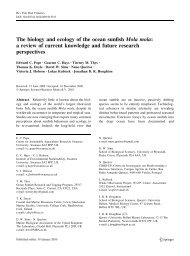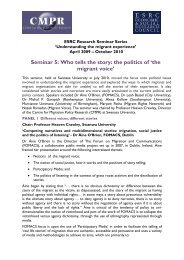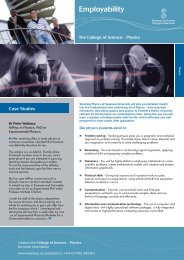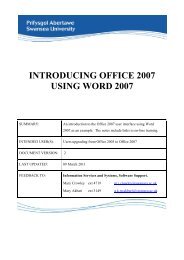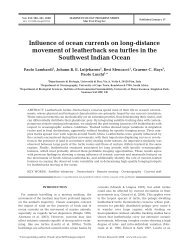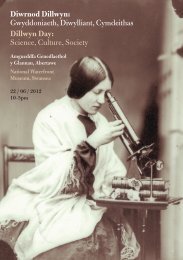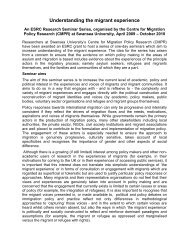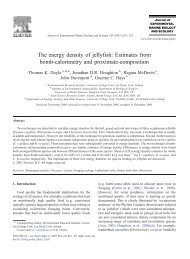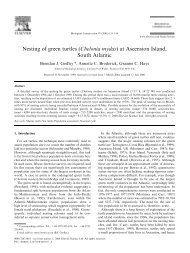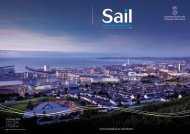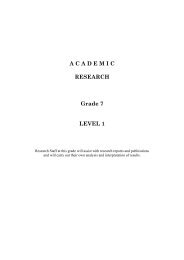Postgraduate Prospectus 2013 - Swansea University
Postgraduate Prospectus 2013 - Swansea University
Postgraduate Prospectus 2013 - Swansea University
You also want an ePaper? Increase the reach of your titles
YUMPU automatically turns print PDFs into web optimized ePapers that Google loves.
Physics<br />
Research opportunities<br />
MPhil, PhD, MSc by Research<br />
RAE2008 50% of research rated<br />
world-leading (4*) or internationally<br />
excellent (3*)<br />
Professors<br />
G Aarts<br />
C R Alton<br />
A Armoni<br />
M Charlton<br />
D C Dunbar<br />
S J Hands<br />
T J Hollywood<br />
B Lucini<br />
C Nunez<br />
G M Shore<br />
H H Telle<br />
Academic and research staff 27<br />
<strong>Postgraduate</strong>s 29<br />
Entry requirements:<br />
Usually at least a first-class BSc or 2.1<br />
MPhys degree (experiment), or a first-class<br />
MPhys degree (theory) in Physics or a<br />
related subject is required<br />
English Language requirement:<br />
IELTS 6.5 (with a minimum of 5.5 in each<br />
component) or <strong>Swansea</strong> <strong>University</strong><br />
recognised equivalent.<br />
Scholarships and Bursaries<br />
A range of postgraduate scholarships and<br />
bursaries is available. For details, please<br />
visit www.swansea.ac.uk/scholarships/<br />
<strong>Postgraduate</strong><br />
Support for research students is available<br />
through other sources, including the EPSRC<br />
and STFC, the European Union, and<br />
industry.<br />
The Theoretical Particle Physics Group has<br />
three STFC-funded PhD studentships<br />
available each year. The Experimental<br />
Groups have EPSRC and Leverhulme<br />
studentships available.<br />
How can I find out more?<br />
Visit our website:<br />
www.swansea.ac.uk/physics<br />
Contact the <strong>Postgraduate</strong><br />
Recruitment Officer:<br />
Email: p.a.jarman@swansea.ac.uk<br />
Tel: +44 (0)1792 295142<br />
Experimental Group:<br />
Email: p.r.dunstan@swansea.ac.uk<br />
Tel: +44 (0)1792 513052<br />
Theoretical Group:<br />
Email: m.piai@swansea.ac.uk<br />
Tel: +44 (0)1792 602315<br />
Visit the <strong>University</strong>:<br />
see page 174 for details<br />
Applications can be made online<br />
at: www.swansea.ac.uk/applyonline<br />
– see pages 176 – 177 for further<br />
information<br />
“The funding opportunities that the<br />
Physics Department offered, through<br />
the Science and Technology Facilities<br />
Council (STFC), was a major factor in<br />
applying to study here. The research<br />
and teaching in the Department<br />
provides a good arena for<br />
postgraduate work, with seminars<br />
from visiting physicists in different<br />
fields almost every week.<br />
”<br />
Sam Alston,<br />
PhD Theoretical Physics<br />
Research Degrees – Physics<br />
134<br />
By recreating conditions that existed<br />
billionths of a second after time began, or<br />
understanding how fundamental<br />
constituents of matter such as quarks and<br />
leptons interact, physicists seek to answer<br />
the big questions. How did the Universe<br />
begin? How can we create, trap, and<br />
harness antimatter? And can we<br />
understand what space and time are<br />
made of?<br />
Physics at <strong>Swansea</strong> <strong>University</strong> enjoys close<br />
collaborative research partnerships with<br />
a range of organisations, including the<br />
European Centre for Nuclear Research<br />
(CERN) in Geneva, the Rutherford Appleton<br />
Laboratory in Didcot, the Karlsruhe Institute<br />
of Technology, as well as many universities<br />
and institutes in Europe and the United<br />
States.<br />
The Department welcomes proposals for<br />
postgraduate research projects that<br />
complement staff research interests.<br />
Research degrees in Physics will:<br />
• provide you with new and specialised<br />
research skills<br />
• prepare you for a career in academic<br />
research and teaching<br />
• equip you with skills relevant for a<br />
rewarding career in a range of diverse<br />
fields<br />
Research Strengths<br />
The Department supports a broad range of<br />
closely connected research groups in three<br />
main research areas: atomic, molecular<br />
and laser physics; condensed matter and<br />
nanoscale physics; and theoretical particle<br />
physics.<br />
Atomic, Molecular and Laser Physics<br />
Spanning small scale lab research to large<br />
scale experiments:<br />
• Antihydrogen Physics. <strong>Swansea</strong> Physics<br />
lecturers are founding members of the<br />
successful ALPHA collaboration. Last year<br />
ALPHA’s trapping of antihydrogen was<br />
voted “Physics World 2010 Breakthrough<br />
of the Year”. The research is mainly done<br />
at CERN, although theoretical studies are<br />
carried out locally and in collaboration<br />
with Stockholm <strong>University</strong><br />
• Low-energy positron physics. At<br />
<strong>Swansea</strong>, a unique low energy positron<br />
beamline capable of producing bursts of<br />
about 100,000 positrons at a rate of 10<br />
Hz has been constructed. This will be<br />
used to investigate positronium energy<br />
levels and electron-position mixing<br />
• Neutrino mass. It has been discovered<br />
that neutrinos have nonzero mass.<br />
<strong>Swansea</strong> is part of a large multinational<br />
collaboration called KATRIN (Karlsruhe<br />
TRItium Neutrino experiment) which aims<br />
to make an absolute mass determination<br />
by making a precise measurement of the<br />
betadecay spectrum of tritium near its<br />
endpoint. <strong>Postgraduate</strong> students involved<br />
with this project will spend part of their<br />
time in Karlsruhe<br />
• Ultra-fast atomic and molecular physics.<br />
In collaboration with groups from UCL<br />
and QUB, ultra-fast effects in atoms and<br />
molecules are studied using femtosecond<br />
lasers. Most of this work is done at the<br />
Astra Laser Facility at the Rutherford<br />
Appleton Laboratory in Didcot.<br />
<strong>Postgraduate</strong> students will share their<br />
time between Didcot and <strong>Swansea</strong><br />
• Ultracold atoms and degenerate quantum<br />
gases. In collaboration with Imperial<br />
College, <strong>Swansea</strong> has worked on<br />
confining and manipulating cold atoms<br />
and Bose Einstein Condensates in<br />
microtraps on atom chips. The group is<br />
developing a sensitive atom chip<br />
interferometer which can be used to<br />
measure weak forces. A new research<br />
programme which aims to detect<br />
quantum degenerate gases using<br />
nanoscale optics has started in <strong>Swansea</strong><br />
• Research is also underway on the<br />
design and implementation of multi-color<br />
laser fields for cooling, sensitive<br />
detection, and coherent manipulation<br />
of neutral atoms<br />
Condensed Matter and Nanoscale<br />
Physics<br />
This group is interested in the fundamental<br />
understanding of the electronic, structural,<br />
chemical and optical properties of<br />
materials on the nanoscale. There is a<br />
strong focus on techniques which<br />
overcome the diffraction limit and using<br />
light on the nanoscale. The group has<br />
experience of incorporating nanoparticles<br />
into soft matter systems. Recently, a new<br />
collaboration has begun with the School of<br />
Medicine to research the possibility of<br />
early pathogen detection using Raman<br />
Spectroscopy. The group is part of the<br />
Multidisciplinary Nanotechnology Centre<br />
and the <strong>University</strong>’s new Centre for<br />
Nanohealth thus postgraduate students will<br />
have the opportunity to perform research of<br />
an interdisciplinary nature and apply<br />
techniques across different disciplines.<br />
Theoretical Particle Physics<br />
<strong>Swansea</strong> <strong>University</strong> is home to one of the<br />
largest theoretical particle physics groups<br />
in the UK and Europe. Its work is aimed<br />
at understanding the fundamental particles<br />
of nature and their interactions.<br />
The work focuses on quantum field<br />
theories and their manifestation in particle<br />
physics and cosmology. This entails not<br />
only some of the most sophisticated areas<br />
of modern mathematics but also numerical<br />
simulations using powerful, specialpurpose<br />
computers. Core research<br />
interests include:<br />
• Gauge theories (supersymmetric and<br />
non-supersymmetric), especially in the<br />
areas of non-perturbative methods and<br />
electromagnetic duality<br />
• String Theory methods to gain<br />
understanding on topics such as Black<br />
Holes dynamics<br />
• The Ads/CFT correspondence and<br />
large-N gauge theories<br />
• The use of string inspired methods to<br />
compute processes of fundamental<br />
importance in collider physics, and to<br />
gain new valuable information on the<br />
high energy structure of quantum field<br />
theories of gravity<br />
• Lattice gauge theories to study Quantum<br />
Chromo Dynamics (the theory of quarks<br />
and gluons), particularly under extreme<br />
conditions of temperature and baryon<br />
density<br />
• New developments regarding the study<br />
of the Quark Gluon-Plasma thought to<br />
exist at high temperature<br />
• Considerations on well-known<br />
symmetries and their possible breaking,<br />
obtaining new insights into the structure<br />
of physics laws at high energies<br />
• The study of the Physics proposed to be<br />
found ‘Beyond the Standard Model’,<br />
mostly in the area of the Supersymmetric<br />
Standard Model and different dynamical<br />
scenarios of electroweak symmetry<br />
breaking, such as technicolour theories<br />
Staff also have research interests in<br />
theories of quantum gravity, particle<br />
cosmology, and condensed matter<br />
systems. The newly discovered relations<br />
among these different topics makes<br />
<strong>Swansea</strong> one of the leading Theoretical<br />
Physics groups in Europe. The group has<br />
close connections with other leading<br />
groups in Europe, USA and Asia.<br />
Specialist equipment includes:<br />
• a low-energy positron beam with a<br />
highfield superconducting magnet for<br />
the study of positronium<br />
• a number of CW and pulsed laser<br />
systems<br />
• scanning tunnelling and near-field<br />
optical microscopes<br />
• Raman microscopes including<br />
tip-enhanced capabilities for<br />
nano-Raman<br />
• a 72 CPU parallel cluster<br />
• access to the IBM BlueGene/Q<br />
Supercomputer which is part of UK’s<br />
DiRAC Supercomputer facility and is<br />
one of the fastest computer systems<br />
in the world<br />
135



